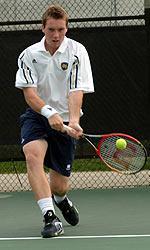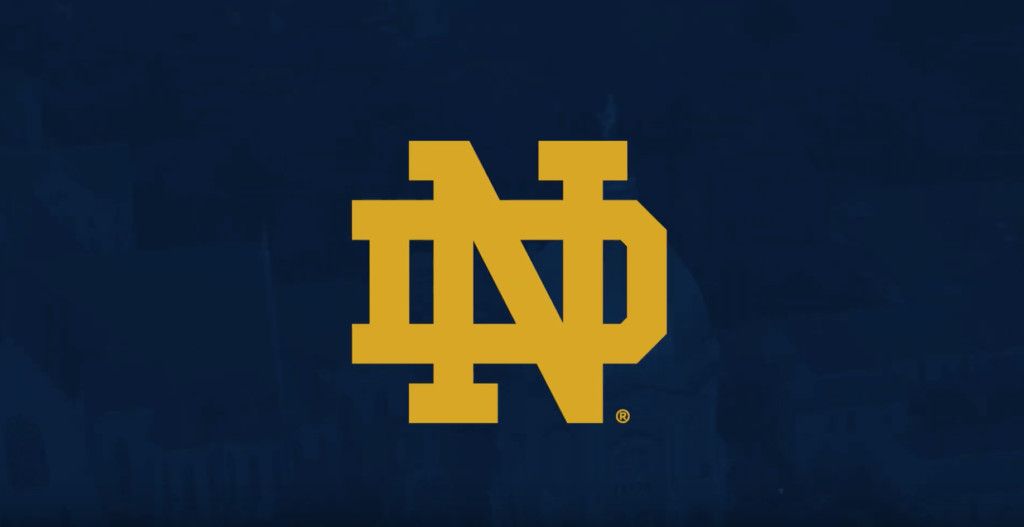March 6, 2004
by Greg Touney
Senior tennis players Luis Haddock and Matthew Scott are more alike then one might think.
Consider: They’ve both been tri-captains the past two years. They’ve both brought international experience to the table. Their career winning percentages in singles matches are less than .01 apart.
And they’re both doing their best to lead a resurgence for the Notre Dame men’s tennis program, one year removed from the only losing season in head coach Bob Bayliss’ 16-year tenure at Notre Dame.
As of the March 2 match against Michigan State, Bayliss’ 2003-04 squad is sitting on an 8-5 record. While the team’s record is back on the positive side of .500, the senior captains have not fallen into complacency.
“So far I think, to borrow an analogy from our coach, we’ve held serve,” Scott says. “We’ve beaten the teams that we’re supposed to beat and we’ve lost to teams ranked much higher than us. But overall, I feel we’re underachieving.”
At this point in the season, both Haddock and Scott seem as determined and focused as ever. The two usually fill the No. 1 and No. 2 singles slots and, along with junior Brent D’Amico, were named this year’s tri-captains. The pair are two of only eleven who have ever earned the distinction of being two-time captains in the 82-year varsity history of the program.
The experience helps — they’re leading a squad that includes a five-man freshman class.
“I think the freshmen are doing well,” Scott notes. “I stressed the importance to them at the beginning of the fall about how much a freshman can influence the team.”
If any two players know about a freshman’s influence, they are Haddock and Scott.
“When we came in, there was a very strong group of guys who were ready to take it to another level,” Haddock remembers. “It was great for both of us to get in there quickly and contribute and maybe help them be the spark that they needed. Our freshman year, we both played well whenever we had chances to play, and I think that helped the team a lot.”
It did. Bayliss’ 2000-01 squad peaked at No. 10 in the national rankings that year — the highest listing for an Irish team since 1992-93.
Both saw their freshman year not just in terms of building a successful team, but in terms of building a successful friendship, too.
“I think Luis and I took pride in [our success],” Scott says. “On another level, it just helped us to grow as friends because we were really kind of in the same boat, and we understood what each other was going through.”
If freshman year was about making an immediate impact on the team, sophomore year marked the time when both made a name for themselves.
“Sophomore year, I think we really looked to build on what we did as freshmen,” Scott recalls. “I think we both saw that we could make an impact on this team. The team we had sophomore year was a team that was a pretty solid one.”

Matthew Scott is one of only eleven Irish tennis players who have ever earned the distinction of being a two-time captain.
|
In aiding the squad, Haddock and Scott each posted two of the better single-season records in recent Irish men’s tennis lore. Scott finished up with a 32-5 record, good enough for the fourth-highest singles winning percentage (.865) in the Bayliss era. Haddock’s year wasn’t too shabby either — his .818 mark (27-6 overall) earned him the sixth-highest spot on the same list.
One of the many reasons that Haddock and Scott have met with success has been the chance to play internationally.
Haddock earned the opportunity to play for his native Puerto Rico as a six-time member of the Puerto Rican Davis Cup team. His experience playing different competitors has helped shape his own game.
“In international tournaments, you have people from South America who know how to drop shot, who know how to angle the ball and who can slice well,” Haddock notes. “I think it helps your strategy and thinking on the court.”
Scott’s international experience comes as a result of living for four years in France, where tennis is much more in the public eye.
“Tennis there is at a whole other level — it’s part of the culture in France,” Scott says. “Tennis has kind of taken a backseat (in the United States), but in France and in most places in Europe, it’s huge.
“Every kid is either kicking a soccer ball or hitting a tennis ball.”
Scott did both during his time at the International School of Paris. The Toronto native, who is now living in Oakton, Va., competed in the Junior French Open and played high school soccer for two years, leading the team in scoring.
“I think living in France is the best thing that could have ever happened to my tennis game,” Scott says. “Without a doubt — just because I think tennis there is at a whole other level.”
Playing in high-pressure situations internationally aided the two, especially during the team’s tough junior year. Notre Dame’s top three singles players graduated in 2002, leaving Scott and Haddock, as well as then-senior Brian Farrell, to tri-captain the team.
“In terms of the development of the team, the biggest jump that we both were forced to make was between our sophomore and junior years,” Scott remembers. “It was difficult, but we supported each other.”
The Irish struggled through a 10-12 season, losing five dual matches by a 4-3 margin. In addition, the Irish missed out on the BIG EAST Conference’s automatic berth when rain suspended their final match and Notre Dame ended up missing the NCAA tournament for the first time in 13 years.
The 2002-03 year did have its bright spots for the two, however.
Both Haddock and Scott cemented their names at the top of Bayliss’ lineup. Haddock, playing No. 1 singles, responded with seven victories over ranked opponents and Scott teamed up with D’Amico to fill the No. 1 doubles slot.
This year, Haddock and Scott have turned last year’s struggles into positives. Both have worked hard on their games over the past four years and now bring a tremendous amount of leadership to the locker room.
“If I wanted to make that transition like I was forced to do my junior year, I had to do what Coach Bayliss calls ‘play outside the comfort zone,” Scott says. “And for me, that was just staying on the baseline, taking balls early and stepping up.
“I’m a lot more comfortable doing that now than I was during my freshman, sophomore or junior years. For me, it has been developing that ability to step up and come in when I need to and also the ability to use the whole court,” Haddock adds. “That’s one of the things I’ve worked the most on in my game.”
This year, their hard work has been a boon to the Irish team. One of the high points of this season was avenging two 4-3 losses from a year ago by defeating Northwestern and Southern Methodist, teams ranked No. 37 and No. 40, respectively.
“Just beating those teams felt great,” Scott says. “But now we’re seeing, ‘Okay, so this is good, we can do that now. Let’s build on that and beat some better teams than that.”
Regardless of this year’s results, one of the most valuable things that Scott and Haddock will take away from their collegiate career is the friendship the two have developed.
“I think (making an impact) has given us a lot more confidence in each other,” Scott says. “You just feed off each other. We’ve been through the same things, taken a lot of the same classes, won the same matches and lost the same matches. It’s kind of a mutual understanding and respect that you’ve both been through.”
The friendship even fuels their tennis play at time. Before the season, the pair made a friendly bet to see who earned the most victories clinching Irish wins this season. (With Haddock’s win against Michigan State, he now has three clinching victories, one more than Scott.)
Without a doubt, Haddock has relished his chance to play with Scott:
“I think it has just been great to have the opportunity to relate to a teammate like that and have success at what you’re doing,”







